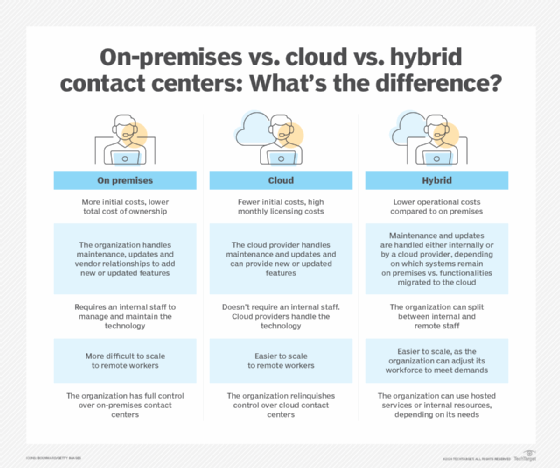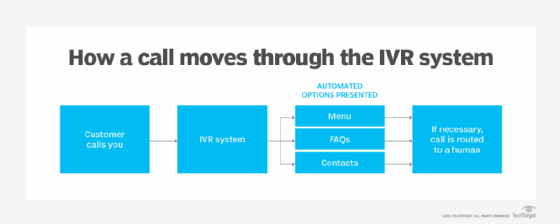What is contact center infrastructure?
A contact center infrastructure (CCI) is a framework composed of the physical and virtual resources that a contact or call center facility needs to operate effectively. Contact center infrastructure enables businesses to manage customer interactions across multiple communication channels. A CCI is typically used by customer service and telemarketing facilities, customer service teams and help desk service centers.
Infrastructure components include automatic call distributors, interactive voice response (IVR) units, computer-telephony integration and queue management.
What are the different types of contact centers?
There are three main types of contact centers -- on-premises, cloud-based and hybrid:
- On-premises. Organizations typically build their on-site CCI by purchasing the required hardware and software and using a telecom provider for their network. Their in-house team often consists of sales, customer service and technical support. The CCI is operated like a data center, with the organization handling all the technology, resources and staffing.
- Cloud-based. These facilities often use a contact center-as-a-service framework that combines a contact center with a cloud-based CCI. Organizations typically provide hardware but rely on a third-party vendor to install and manage software and networking.
- Hybrid. This type of CCI combines on-premises and cloud-based technologies. Employees can work either in-house or remotely. Organizations typically use a mix of in-house staff and outsourced resources.
An organization should carefully evaluate its needs -- including business size, security needs, plans for growth, budget and level of control -- to determine which CCI will best meet its objectives.

Contact center infrastructure requirements and how to set one up
Contact centers require the following components:
- Hardware. The physical components needed to set up a contact center include local area networks, telephony equipment, computers and workstations, routers and switches, power backups, and either an on-premises or cloud-based data center.
- Software. The digital tools needed to run a contact center include customer relationship management (CRM), quality management systems, workforce management systems, automatic call distribution, call recording and monitoring software, analytics tools and security software.
- Telecommunications network. Voice over IP is an example of a widely used telecommunications network for CCI.
- Agents. Contact center agents are employees who work directly with customers. They handle inquiries, provide support and resolve customer issues. To work effectively, they require adequate workstations and hardware, training, contact center manager and customer feedback, and tools for remote work, if applicable.
To set up a contact center, an organization should do the following:
- Define business needs and goals. The organization determines the size of the contact center, service goals and the key performance indicators (KPIs) it plans to measure.
- Choose the right contact center software. The organization determines its software needs based on whether its CCI will be on-premises, cloud-based or hybrid.
- Set up network and telephony systems. The business ensures that there's enough network bandwidth to handle the expected number of requests and that these systems are secure.
- Deploy workstations and any hardware. The organization sets up workstations and any other hardware needed for agents.
- Install and set up call center software. The organization installs and configures any required software, which might include CRM, workforce management systems, call recording and security software.
- Implement security. The organization puts required security measures into place. This might include installing firewalls, virtual private networks, antivirus software and encryption systems.
- Train staff. The business trains its staff on systems, software and any relevant customer service protocols.
- Monitor and update. The organization uses reporting and analytics tools to monitor and improve call volumes, agent performance and customer satisfaction. The infrastructure should also be continually monitored and updated to address potential performance or security issues.
Key features of contact center infrastructure
CCI includes essential features such as omnichannel support and IVR, among others.
Omnichannel support
Because contact center infrastructure often crosses many different communication channels and technology systems -- including phone, email, social media platforms and live chat -- organizations must be able to integrate the customer data generated in those channels.
This integration is important for creating a positive customer experience in which customers don't have to repeat information as they go between multiple channels. Agents, sales reps or other company employees have the same view of the relevant information to provide the customer with seamless customer service.
Interactive voice response
IVR systems can route customer calls to an available agent who is knowledgeable about the product or issue. This feature helps create a positive customer experience, as do knowledge bases that enable customer service reps to look up necessary product, service or customer information to best serve a customer.

Automation and integration
Outbound automated technologies can also help contact centers reach customers and prospects efficiently. Self-service technologies are becoming part of the modern contact center infrastructure, enabling customers to handle some lower-level issues independently before requiring the help of an agent.
Contact center infrastructure often involves integration between CRM, marketing and service databases, as well as integration with other systems, including enterprise resource planning and financials. In some cases, call data is also integrated with data generated through social media monitoring technologies.
Analysis and reporting
Speech analytics and other intelligence applications are also essential to contact center infrastructure. They enable companies to analyze the productivity and effectiveness of contact center operations, from call quality and time elapsed to other metrics, such as first call resolution and other call center KPI indicators.
Analytics applications and video analytics help identify situations in which customers and agents are getting frustrated and need to diffuse the situation -- or, alternatively, situations in which customers are pleased with the interaction.
Communication
Computer telephony integration (CTI) connects phone systems with computers. This technology enables features such as the automatic identification of customers through caller ID from phone numbers and integration with CRM systems. CTI helps ensure that agents have any needed data when a call starts. It also supports features such as call routing, recording and monitoring.
Universal queue management
This critical element ensures smoother customer interactions across different channels. In this process, all customer queries are consolidated into a single queue. Interactions are then prioritized based on predefined rules -- such as urgency or customer value. This helps ensure that customers are served efficiently, despite being on different channels.
There are many granular requirements to consider before implementing a contact center. Learn more about how to define different contact center technology requirements.








